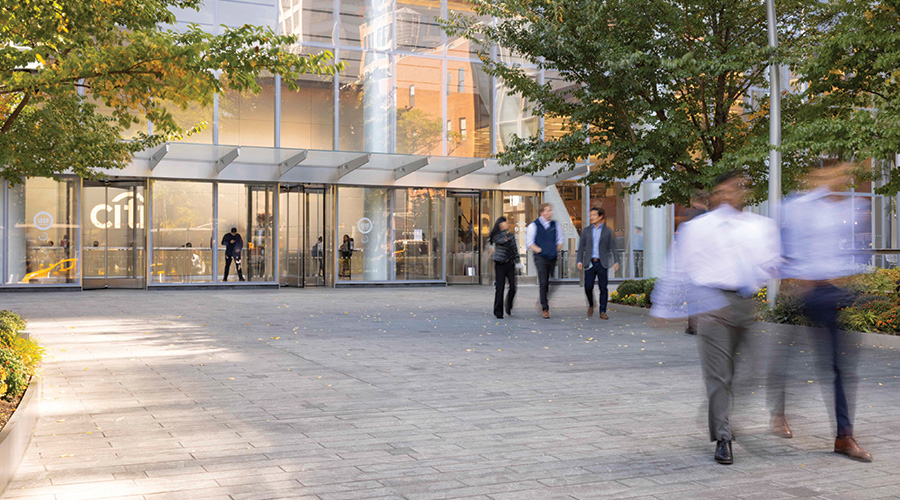Graduating to Green
Bob Hascall is making sustainability part of every facilities decision at Emory University
By Greg Zimmerman, Executive Editor
Tour Atlanta’s Emory University with Bob Hascall, vice president of campus services, and he’ll point out items such as benches made of recycled seatbelts, tables and countertops fashioned from reused construction marble, trees that have been relocated — instead of cut down — to make room for buildings, and robotic animal cage washers that save water, energy and make waste-recycling easy. These “eco-novelties” are microcosms of sustainable successes all over campus: accomplishments that have been driven by Emory’s emphasis on sustainability in design, construction and planning.
This green philosophy is illustrated in many ways — perhaps most strikingly by the five LEED-certified buildings on campus — the most of any college. (Seven other projects in the works either have already applied to be LEED certified or being designed to LEED standards.) Policies have been implemented to transform the campus to be more pedestrian-friendly; land-use planning, incorporated into Emory’s latest facility master plan, will ensure the lush, verdant campus will maintain designated green spaces, forests and creek beds for decades; and the campus aims to reduce energy use by 25 percent from 2005 levels by 2015.
Hascall, who leads a staff of 680 and oversees a budget of more than $60 million, has been the guiding hand behind many of these environmental initiatives nearly from their inception. His responsibilities, following a promotion in May 2005, grew to include everything from facility management, campus planning, and design and construction to parking, fire safety, transportation services and campus security. But even with this breadth of responsibilities, sustainability has always been the underlying principle by which Hascall makes decisions, and his cause has been furthered by an institutional culture that has always embraced environmentally conscious decisions. But that’s not to say there weren’t challenges.
Hascall started at Emory as associate vice president of facility management in January 1997 after he left a similar position at the University of Southern California.
“Before I arrived, this organization was dysfunctional,” says Hascall. “Projects were always over budget. The buildings didn’t satisfy the needs of the people occupying them. They were never on schedule. So every aspect of project delivery was problematic.”
Hascall was tasked with picking up the reigns of a master planning process and a project to develop design and construction standards, both of which were already under way when he arrived. “The master planning process would help us decide how we’d move forward with building projects in the future,” he says. “And we created standards for how we built so the campus would look like it was knitted together. We wanted to be thoughtful about how we put buildings on the campus in the future and how they connect the campus fabric.”
Architects, engineers, facility managers and maintenance staff were all instrumental in developing the standards. “At the time, the engineers and architects never talked to the maintenance people,” says Hascall. “So we always had finger-pointing. The maintenance people would say, ‘You’re designing stuff we can’t maintain.’ The architects would get defensive and say, ‘Well, you maintenance guys just don’t understand. Our role is to design these buildings and make them pretty.’ So we had all this tension. I insisted that maintenance people and the architects work together to develop the standards.”
Including sustainability was another key consideration. The new architectural guidelines and standards included green building hallmarks such as a requirement for commissioning new buildings — both mechanical systems and building envelope components such as windows and roofs. Light-pollution reduction methods, low-VOC materials, resource conservation strategies and waste recycling also became part of Emory’s way of building as it began implementing the 1998 master plan.
However, it wasn’t until Hascall and some of his staff members attended a workshop in 2001 that he discovered LEED and recognized it as a specification that would dovetail with Emory’s standards.
“Our requirements for energy and resource conservation were at a pretty high level,” says Hascall. “It wasn’t a big stretch for us to go LEED.”
The First LEED Project
The 325,000-square-foot Whitehead Biomedical Research Center was already in the early stages of construction when Hascall returned from the workshop excited about LEED, but he did not want to wait for a new building to try for Emory’s first LEED certification. Of course, because the design of the building was already complete, because LEED was relatively new and because certification carried a cost premium, Hascall had some convincing to do.
The first step was convincing the project’s sponsor — Emory’s school of medicine, in this case. At Emory, the organization that occupies a new building is identified as the project’s sponsor and pays half the cost of new construction projects. The university pays the other half.
Hascall’s argument in favor of LEED was simple: “You’re going to have to pay a little extra, around 1 to 2 percent, but you’re going to have a better building and it’s going to save you money.”
Because the school of medicine would be responsible for operational costs, based on calculations of energy and water savings, administrators decided LEED was worth the old college try. Plus, they recognized the public relations value of being the first LEED-certified building on campus, says Hascall.
The second step was convincing those in university administration who held the purse strings. But gaining the support of the executive vice president, chief operating officer, president and finally the board of trustees turned out to be relatively simple. Hascall showed the energy savings payback on the initial $500,000 investment in heat recovery (enthalpy) wheels to be less than five years. While not the only design change required to make the building certifiable under LEED, the heat wheels were a vivid example of the financial benefits of building to LEED standards.
As a result, the president even volunteered to help Hascall present LEED to the board of trustees. “We demonstrated the savings that would accrue from that one feature,” says Hascall. “And we asked them to imagine multiple features like the heat wheels in buildings all over campus.” The vote was unanimous in favor of LEED.
The final challenge was actually tweaking the design — a process that required getting the architects and contractors on board with LEED. “It was difficult because neither the contractor nor the design professionals had experience with LEED,” Hascall says. “They had a steep learning curve, as we did. But when people started being innovative and creative, everyone got excited. They started thinking about even more ways to be energy efficient and to recycle construction waste.”
The $82 million facility received a silver certification in April 2002. The robotic animal cage washers in the basement of this building — a modification from the original design — earned a LEED credit for innovative design. The building also earned water efficiency credits for a system that recaptures and reuses about 4.2 million gallons of condensed water per year from the building’s cooling coils.
With the success of this first building, the board of trustees passed a resolution that all future buildings should be designed to be LEED certified, assuming it made economic sense to do so.
“With LEED, we’re willing to pay a premium for two reasons,” says Michael Mandl, executive vice president of finance and administration, co-chair of the university’s sustainability committee, and Hascall’s boss. “The issue of sustainability is part of our vision. It’s consistent with our values and what we want to be as an institution. Secondly, we actually don’t believe there is a premium. At the end of the day, LEED is a financially justifiable way to build.”
Soon after Whitehead, the university’s Candler Library renovation and addition project received a silver certification and The Math and Science Center and Winship Cancer Institute met the certified level. Those three buildings, plus Whitehead, complete the campus’s portfolio of buildings certified under LEED for new construction (LEED-NC). Three other LEED-registered projects are built and occupied, and awaiting the U.S. Green Building Council’s ruling on level of certification. All told, Emory’s stock of LEED buildings includes more certified and soon-to-be-certified buildings than any other college campus.
A New Way to Green
With the advent of the LEED for existing buildings (LEED-EB) rating system in January 2002, Hascall recognized a whole new world of certification opportunities, and readily volunteered to take part in the rating system’s pilot phase. Hascall registered the Goizueta Business School building, built in 1998, for the program, assuming that because it was relatively new, certification would be easy. Turns out it wasn’t the slam dunk Hascall envisioned. Collapsed ductwork was driving up energy costs, a problem that had a $100,000 price tag to fix. Once the ductwork and a few other problems were corrected, the building received a gold rating under the LEED-EB pilot rating system. Hascall estimates the improvements saved $150,000 in the first year after certification of the 122,000-square-foot facility.
The experience led Hascall to begin looking at the rest of the university’s buildings using LEED-EB as an assessment tool. Hascall and his team, with the help of a consultant, have recently begun creating a prioritization system to determine the feasibility of certifying existing Emory buildings. Buildings with much higher energy usage are given higher priority. If facility problems are driving up energy consumption, Hascall wants to find out what they are and fix them sooner rather than later, if financially feasible to do so.
Hascall keeps a database of metrics such as consumption of steam, chilled water and energy for each building, and benchmarks these against peer institutions. The prioritization system and benchmarking are also key steps in achieving the goal of 25 percent reduction in energy use. Hascall does admit that 25 percent is a stretch goal, but at least it provides impetus to make aggressive energy conservation decisions, he says. “All my staff are giving me a hard time about how we’re going to achieve this goal,” jokes Hascall.
The process of facility assessment is also a key component of an updated master plan that was released in November 2005. Because two of Emory’s long-term strategic goals are to increase student enrollment and decrease the faculty-to-student ratio, and because Emory is fairly locked into its existing real estate, difficult building decisions loom.
“The new master plan is really bold,” says Hascall. “We’re not just looking at where we can put new buildings, but we’re addressing functionality of original buildings. Should we keep investing in them or tear them down and start over?”
In all, the new master plan identifies 45 building projects, with 41 charted over the next 15 years. The new facilities range from new residence halls to academic space to a new $1.5 billion hospital to be built by 2016.
“The goals of master planning are multifaceted,” says Jennifer Fabrick, Emory’s university architect. “Weaving discussions of the university’s strategy and master facility plan together is part of accomplishing those goals. We also hoped to identify the lessons learned from the 1998 plan and update it with input from groups all over campus.”
The new master plan, which is looking out as much as 50 years to match strategic goals with facility space, also has land-use provisions that specify that existing green space will not be built upon or disturbed. An outsider might think a provision like that would lead to wars between those wanting to develop the campus to its saturation point and environmentalists who want to maintain the green status quo. But because of the long-term environmental philosophy at Emory, there were relatively few arguments.
“The land-use plan was developed independent of the master plan,” says John Wegner, Emory’s campus environmental officer. “We overlayed one on the other and discovered that less than 1 to 2 percent of land was land we disagreed on.”
The land-use part of the master plan means that of Emory’s 703 acres, 385 acres — roughly 55 percent — will be maintained as protected forests and green space.
“The land-use plan takes advantage of the master planning process in that we won’t have to debate every site proposal from scratch,” says Mandl.
Hascall says that the most important part of including a land-use plan in a facility master plan is having the support of leadership. Wegner and Mandl both describe the land use plan as a “significant accomplishment” and one that other universities will look to.
Work Never Finished
The new master plan also expands on a goal originally set forth in the 1998 plan — creating a more pedestrian-friendly campus. After the 1998 plan, two major roads through campus were closed to outside traffic and the university expanded its shuttle bus program to ease the transition for students. The new plan calls for further pedestrian-focused measures, including eliminating the shuttle buses on many campus thoroughfares — an “unexpected twist” that was actually passed by the student government, says Fabrick.
The continued transformation of campus to one that’s pedestrian-friendly and maintaining green space are two of Hascall’s successes, but also ongoing goals. Cruising around campus with him in a golf cart, dodging the occasional student too used to not having to watch for vehicles on campus, he’s quick to point out future plans to make the entire campus nearly vehicle-free and how trees, forests and grassy student commons will be protected.
“I’m proud of how we’ve developed the campus over time, making it more warm and inviting,” he says. “And I’m most proud of our sustainability effort. It’s just the right thing to do as a teaching and research institution.”
But Hascall would be the first to acknowledge that a lot of work remains. Hascall and Wegner both sit on the sustainability committee co-chaired by Mandl, which has identified ambitious sustainable goals for the future: the 25 percent energy reduction, for instance. Hascall will certainly play a significant role in guiding those goals to fruition. Fortunately, he has not only the respect of his colleagues, but also the support and trust of the university’s administration.
“When I think about leadership, I ask three questions,” says Mandl. “‘Can you articulate a vision? Can you work with people to achieve that vision? Can you organize resources to achieve that vision?’ Bob does all those things.”
Related Topics:











